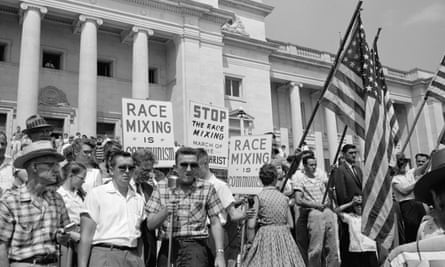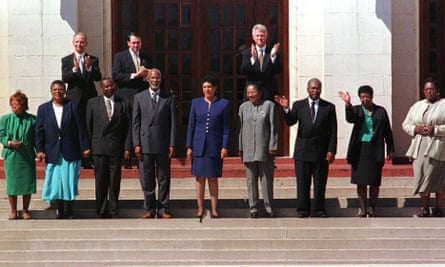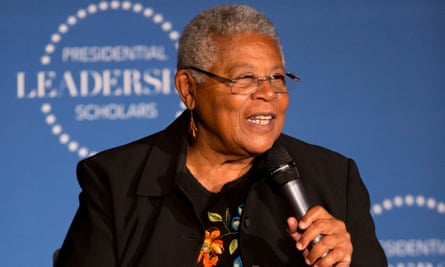Minnijean Brown Trickey didn’t intend to make a political statement when she set off with two friends for her first day in high school. She was, after all, only 15. “I mean, part of growing up in a segregated society is that it’s a little sort of enclave and you know everybody,” says Trickey, who is African American. “So, I was thinking: ‘Wow! I can meet some other kids.’”
Central high school in Little Rock, Arkansas, seemed to have a lot going for it. “The black school was kind of far away and there was no bus,” she says. “We went to get new shoes and we were really trying to decide what to wear. So we were very teenage-esque about it, just totally naive.”
It was September 1957, the Jim Crow era of racial segregation, and nine black pupils little guessed they were about to plant a milestone in the struggle for civil rights to follow those of Emmett Till, a 14-year-old lynched in Mississippi in 1955, and Rosa Parks, who refused to give up her seat to a white passenger on a bus in Alabama later the same year.
Brown v Board of Education, the landmark 1954 supreme court ruling that segregated schools were unconstitutional, should have meant she and fellow pupils could take their places at Central High. But Governor Orval Faubus of Arkansas, in the deep south, remained defiant and used the national guard to block their enrollment. The African American children were left in limbo for three weeks.
On the first day of term, the national guard were there to stop the nine entering Central High, where all 1,900 attendees were white. Three weeks later, on 25 September, the group braved a hostile white crowd, climbed the school steps and were escorted to class by US army troops. They became known and revered as the Little Rock Nine.
Eight of the nine are still living and will return to Little Rock on Monday to mark the 60th anniversary of the US’s first major battle over school segregation. A day later, several will be in Washington to speak at the Smithsonian National Museum of African American History and Culture. It will be a moment to reflect on how far the US has come in unravelling educational apartheid – and whether, in recent years, progress has stalled or even reversed.
The share of “intensely segregated” black schools has trebled over the past 25 years, according to research by the Civil Rights Project at the University of California, Los Angeles (UCLA), which warns of a “resegregation” taking hold. Trickey, who turned 76 earlier this month, asks bleakly: “What kind of country doesn’t see education for all children to be the primary value? I think the US has two values: segregation, which they do so well, and violence.”
Speaking by phone from her longtime home in Canada, she can still remember vividly the combination of segregation and violence that left her “whole body shaking with fear and shock” as a teenager six decades ago.
On 23 September 1957, the group did get into the building with police protection. But an angry mob of more than a thousand white people had gathered in front of the school, chanting racist abuse such as “Go back to Africa”.
“I really think that we were afraid to look at the mob; at least I was,” says Trickey. “So we just heard it and it was like a sports event, that sound, the roar, but it was a roar of hatred, and just thinking about it makes me shake.”
She says of her young self: “I’m nobody. I’ve never been hated. I’ve been loved all my life. I’m beautiful. I’m smart. I just can’t believe this. So I kind of describe it as having my heart broken. Of course, you know as an ‘American’ even living in a segregated society you do all the anthems and the pledges and you’re hiding under the desk from the Russians, and so brainwashing works well. So the heartbreak was: ‘I’m supposed to be living in a democracy. What? These people hate me. They don’t know me. They want to kill me.’”

The mob started a riot and police decided to remove the students for their own safety. “At about 10am they said: ‘You’ve got to come down to the office,’ and we went down into the basement. They put us in these cars and the cops driving the cars were shaking. They had the guns and sticks and they were scared. ‘Oh wow, this is scary.’ Some of us were told to keep our heads down.
“Melba Pattillo Beals [another of the nine] says she overheard a person saying: ‘Once you drive, do not stop.’ So they quickly drove us out from the side, then later we watched TV and could see the mob was going to go inside.”
The crisis was cause for Washington to intervene. President Dwight Eisenhower sent in 1,200 paratroopers from the 101st airborne division. The soldiers escorted the students single file into the school for their first full day of classes and dispersed the demonstrators. The US’s racial shame had been exposed, shown on TV and reported in newspapers around the world. “Negroes escorted into school,” reported the Manchester Guardian, noting that two white protesters clashed with the soldiers and were injured.
Richard Kahlenberg, a senior fellow at progressive thinktank Century Foundation, says he regards it as a turning point for the country: “We were accustomed to having schools segregated by race. We in essence had a system of apartheid in our schools that had been widely accepted in the south. The Little Rock Nine were an incredibly courageous group of African Americans that stood up and said this system of apartheid, which had been struck down by a supreme court decision, could not stand.
But although 25 September is the date people remember, troops remained at Central high school for the rest the school year and the Little Rock Nine ran the gauntlet of hatred every day. They were taunted, assaulted and spat upon by their white counterparts; a straw effigy of a black person was hung from a tree. They were kept apart in different classes so they could not vouch for each other’s claims.
“It’s the going back: that’s the bravery, that’s the courage,” Trickey says. “It’s the going home and saying: ‘Wow, they’re not stopping me, I’ll go back no matter what.’ There is no courage at the outset: the courage kicks in later.”
Trickey was first suspended, and then expelled, for retaliating against tormentors who went unpunished. She was invited to New York to live in the home of Kenneth and Mamie Clark, social psychologists whose groundbreaking work showed the negative impact of segregation on African American children, and finished her secondary education. She eventually became an activist, environmentalist and social worker with a spell in the Bill Clinton administration.
Beals became a journalist and author and lives in San Francisco; Carlotta Walls LaNier, the youngest of the nine, became a property broker in Denver; Elizabeth Eckford served in the army, became a probation officer and lives in Little Rock; Ernest Green served in the Jimmy Carter administration and worked for Lehman Brothers in Washington DC; Gloria Ray Karlmark worked as an aerospace research technician and lives in the Netherlands and Sweden; Terrence Roberts became a psychologist and management executive in Pasadena, California; Thelma Mothershed Wair had a career as a teacher and worked with young offenders and the homeless, then moved back to Little Rock; Jefferson Thomas fought in Vietnam, became an accounting clerk with the defence department and died in Columbus, Ohio, from pancreatic cancer in 2010.
The nine were awarded the Congressional Gold Medal by Clinton in 1999 and have met for reunions, particularly on anniversaries. “We’re on conference calls and we’re giggling and we say about ourselves that, when we get together, we become teenagers again,” says Trickey.

A cause for optimism – and caution
But the legacy of Little Rock is non-linear, and cause for both optimism and caution. While significant strides were made towards desegregation in the 70s and 80s, a series of decisions by the supreme court between 1991 and 2007 authorized the termination of cross-district bussing, local court supervision of desegregation plans and limited use of race-based admissions. An interplay of race, class and geography is at work, including the middle class’s ability to self-replicate by buying homes near the best-funded schools.
The Civil Rights Project at UCLA reported last year a “striking rise” in double segregation by race and poverty for African American and Latino students concentrated in schools that “rarely attain the successful outcomes typical of middle-class schools with largely white and Asian student populations”. The year 1988 was the “high point” of desegregation for black students in terms of the share of students in majority white schools, it found, but since then the proportion of “intensely segregated nonwhite schools” (those with 10% or less white students) rose from 5.7% to 18.6% of all public schools. There is little sign Donald Trump and his education secretary, Betsy DeVos, regard this as a priority.
Speaking from the steps of Central high school for the 40th anniversary in 1997, Clinton warned: “Segregation is no longer the law, but too often separation is still the rule. Today, children of every race walk through the same door, but then they often walk down different halls. Not only in this school, but across America, they sit in different classrooms, they eat at different tables. They even sit in different parts of the bleachers at the football game.”

The Little Rock Nine could be forgiven a sense of frustration at such uneven progress. “It’s all institutional and it’s all centuries old,” says Trickey, “so we’re seeing the result of policies that have been made over time. It has become more visible because the people who are running the country now are profoundly intentionally ignorant.”
After the first black US president was succeeded by a man supported by white supremacists and the Ku Klux Klan, Trickey sees history coming full circle. “People went into their basements and pulled out the old signs that they used in Little Rock, in Selma, across the country. “Integration is a sin”, “Integration is an abomination against God”, “Integration is communism”. They’re using the same ones they used 60 years ago. But there will be young people like the Little Rock Nine who are gonna keep going; I’m trying to train as many of them as I can.”
The US capital offers one glimpse of the wider trends. New research by the Albert Shanker Institute shows that, in Washington DC, 86.1% of the typical black student’s peers are also black, and more than half the private school student population is white compared with less than 10% of public school.
DC Scholars public charter school, which opened in 2012, is just five miles from the dome of the US Capitol and the most powerful legislative body in the world. The school’s bright, colourful walls include photos of the “scholar of the month!”, a table showing percentages of students who improved their maths and reading scores and a series of university pennants including Harvard and Yale. There are 512 pupils, of whom 31% have disabilities – for example, learning disorders or ADHD – which is treble the national average. The student body is 100% African American.
Tanesha Dixon, principal of the middle school, explains this as being largely down to geography: “We are east of the river. This is a very black community. We have middle-class children and lower-class children; not every student is a ‘latchkey kid’ or from a broken home. We have a diversity because the black experience is not a monolithic experience.”
She adds: “I’m not even thinking of the colour of their skin; I’m thinking of the quality of the education they’re getting. The fact we’ve been able to provide a high quality of education east of the river every day is one of the reasons I keep coming to work.”

Asked how the Little Rock Nine would react if they visited, Dixon says: “I would hope they would be shocked in a very good way, amazed at the calibre of discussion that schools are having. I would put my school against any in the city to read, write and do arithmetic. It’s kind of cool to be a nerd here. Kids of colour are going to a school where they have access to great teachers and great resources.”
The debates remain complex, progress uneven, the answers elusive. Justin Reid, director of African American programmes at the Virginia Foundation for the Humanities, says: “Little Rock was definitely a flashpoint in the civil rights movement and inspired activists, but it also galvanised many southern states in how they attacked integration efforts. They did it in a quiet, subversive way; they didn’t want the media attention that was attracted in Little Rock. You saw legislators think carefully: how can we block integration?”
He adds: “I think the Little Rock Nine would have to be disappointed. We’re regressing. The peak time for integration was the 70s and 80s. We now live in a society where there is more segregation than ever before.”
Speaking by phone from Little Rock, Ernest Green, now 75, admits he is “disappointed” but insists he is also “pleased” by the evolution of the past 60 years.
“The US is still segregated by housing and employment, which are the two pillars we still have to struggle with,” he says. “But I believe our experience will act as an inspiration to many young people. It may inspire some on the other side: there’s probably a crowd that wants to go back to slavery, but we won’t let them.
“I survived a year of Orval Faubus, the Arkansas governor, in 1957. If we pace ourselves according to what Trump wants, obviously we’ll go backwards. The idea is to continue the fight and push for equity in this country.”
Green recalls a little-remembered line from Martin Luther King’s “I have a dream” speech in Washington in 1963, in which the civil rights leader argued that America had defaulted on its constitutional promise to citizens of colour, like a check that comes back marked “insufficient funds”.
But King refused to believe the bank of justice is bankrupt.
“Dr Martin Luther King said the US had given black people a bad check; we’re still waiting for the check to be honoured.”
